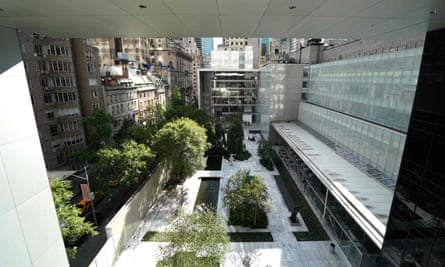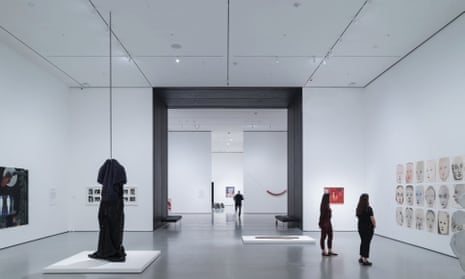New York’s Museum of Modern Art (MoMA) unveiled its new $450m expansion on Thursday in a revamp of the gallery – including a radical “remix” of its permanent collection, which will see famous works exhibited alongside those of lesser-known artists.
The popular Manhattan museum, which attracts 3 million visitors a year, has been closed since June for the renovation and rehang but will reopen to the public on 21 October with an additional 47,000 sq ft of space – an increase of nearly 30% – after the installation of a new glass and blackened steel extension.
New features include a studio space for performance, process and time-based art, which MoMA says is the first of its kind in a major museum in the world, where visitors can experience the artistic process firsthand and watch rehearsals.
For the first time, an entire floor of the six-floor gallery – including the sculpture garden and ground floor galleries – will be free, opening up access to those who cannot afford the $25 entry fee.

MoMA’s director, Glenn Lowry, said the museum’s aim was threefold: to make more space for the collection, reorganise the gallery and to bring more of the city into the space. “Often museums feel like sealed boxes and we wanted to get away from that and to take advantage of the fact that we’re located in this fascinating part of New York city,” he said at a preview of the space.
Historically, the museum has always hung works in chronological order with different mediums separately. But now visitors will see works from different eras, places and mediums displayed side by side.
Although the galleries are still ordered according to loose time periods, and some rooms follow a particular theme such as action painting, there is far greater scope for placing works alongside one another that would not ordinarily be seen together.

This new approach is perhaps best exemplified on the fifth floor where Picasso’s 1907 painting Les Demoiselles d’Avignon is hung close to Louise Bourgeois’s 1947-53 sculpture Quarantania, I and Faith Ringgold’s 1967 work American People Series #20: Die, depicting a scene from a race riot.
Lowry said part of the purpose of this is to connect the past and present.
Presenting Picasso alongside Ringgold, it “reframes” the artist, he said. “Introducing Faith Ringgold’s painting, which is violent, introduces issues around race but it also talks about the impact of colonisation and decolonisation. It reframes Picasso differently. It doesn’t diminish Picasso, it simply means that there’s another conversation you can have around Picasso.”
He added: “Throughout the building we have tried to identify moments where unexpected relationships suddenly change the way we see something … You can take works of art that are roughly contemporaneous but from different parts of the world and they spark conversations with each other that are unexpected.”

It also reflects the way people in 2019 consume a wide variety of images in a digital world where they are often shown out of context and in untraditional settings.
“We all live now with screens and we’re used to this kind of lateral projection of imagery,” said Lowry. “You tap here, you get this, you connect this. There’s a kind of seamlessness to the way we absorb both images in the virtual world and images in the physical world. And so I think part of what we wanted to do was to clearly recognise that our audiences, not just our younger audiences, all of our audiences, are experiencing imagery in new and different ways.”
There is greater diversity among the artists behind the works, which will be on regular rotation so that every six months a third of the works will be different.
The museum said that works by women have increased fivefold since the early 2000s, although 59% of artists across their collection are still male, with 28% female and 13% are people who are not gender-specific or are not single entities but groups, collectives and companies. They have also increased works from outside North America and Europe.
Lowry said: “In the last 20 years we’ve made a very big push to ensure that representation of women, of African Americans and of course artists from elsewhere in the world was even more robust than before.”
The museum has also tried to make itself more approachable to people outside of the art world by avoiding art-specific terminology in their signs.
Among the opening works on display are Rainforest V (Variation 1) by David Tudor and Composers Inside Electronics, an installation in the new studio, Richard Serra’s Equal and a new site-specific work by Yoko Ono, Peace is Power.

Exhibitions include Betye Saar: The Legends of Black Girl’s Window, Sur moderno: Journeys of Abstraction – The Patricia Phelps de Cisneros Gift and member: Pope.L, 1978-2001.
The museum, the 90th anniversary of which falls this year, is also partnering with the Studio Museum in Harlem.
The extension was designed by Diller Scofidio + Renfro with Gensler.
The architect Elizabeth Diller said she wanted to make the museum more comfortable and inviting and to enable visitors to have “more agency” moving around the building. “For people to have options, I think that’s a good thing,” she added.
Diller, who recently also worked on New York’s new arts venue the Shed at Hudson Yards and previously the High Line and refurbished the Lincoln Center, said it is a positive time for New York arts buildings.
“Oh it’s an amazing time. For my studio especially because we were involved in two amazing projects in New York and both iconic and they couldn’t be more different from each other.”
